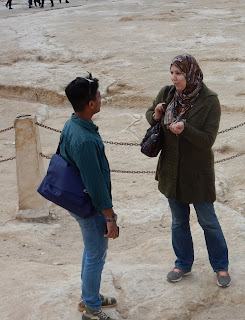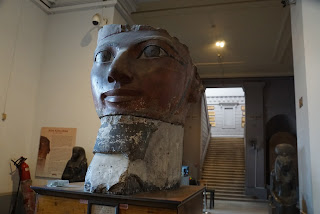Day 2 - Cairo
 |
| Suzi with Malaysian friend |
Suzy's probably in her early thirties, generally attractive, speaks English well, wears a hijab, jeans, a waist length leather jacket and runners. She introduces us to the driver who's about
my age and wears dress pants, loafers, a red sweater; very professional looking. He holds the door to his small, four door Toyota so we can get into the backseat. Suzy rides shotgun.
Unlike the previous day, congestion doesn't slow our drive all the way to the Egyptian Museum located at one end of Tahrir Square. I'm surprised that this could have been the centre of riots in 2011 that involved millions in demonstrations and at least 846 people were killed and over
6000 injured.
The
driver parks his battered car underground with all the other battered cars that
make up the vast majority of vehicles in this city. We spot a couple of tour
busses in front of the museum and I worry that the place is going to be packed. We
purchase tickets that give us access to museum and the mummies. Why we need to see the mummies I have no idea.
 |
| King Djoser |
Suzy stops in front of a bust and asks if it represents a woman or man. I think this must be a trick question because it really looks female and so I say male. Nicola also guesses male. Wrong. She said that if we’d got it right, she would have given us a prize. We’ll never know what that might have been. She explains that it's a statue of Hatshepsut, one of the only female pharaohs who reigned for about 20 years as co-regent with her stepson, Thutmose III. That was after her half-brother and husband, Thutmose II died around the age 12. The term, all in the family, was carried to a whole new dimension in ancient Egypt.
The highlight of the museum is the exhibit of King Tutankhamun tomb items discovered by
Englishman Howard Carter way back in 1922. Having died at age 19, King Tut wasn’t a particularly
great Egyptian pharaoh however his tomb is one of the only discovered by Egyptologists that hadn’t already been robbed. By
the third and final kingdom, the pharaohs were pretty good at hiding their tombs however the treasure hidden within meant that many through the millennia had been willing to expend a lot of energy towards their discovery
the third and final kingdom, the pharaohs were pretty good at hiding their tombs however the treasure hidden within meant that many through the millennia had been willing to expend a lot of energy towards their discovery
King Tut had many sarcophagi, each nested within the other like a Ukrainian nesting doll. The outermost
sarcophagus was made of wood, the second, also of wood but covered with intricately patterned gold foil and the final inner sarcophagus was construct of solid
gold.
The highlight of Carter's finds was Mr. Tut’s funerary mask that’s probably the most commonly viewed image of a pharaoh. It’s held within a high security area that requires a special ticket to enter. Suzy waits outside.
Like many objects I've seen in books, television, the internet and movies, it's smaller than I envisioned. Nevertheless, it has amazing detail and beauty and it's solid gold. Unfortunately, but then again, what does it matter, I wasn't able to take a picture of the mask nor any other objects within this secured room.
These were a bit ghoulish and kind of dumb. The bodies are eviscerated and the organs put in a special sarcophagus and buried apart from the body. Wigs have been placed on some to replace lost hair and gems used on some to replace eyes. I don't need to see another.
The museum is so filled with objects that another is being built; many, many sarcophagi, sculptures of pharaoh, queens, and gods, palanquins to carry royalty, and papyrus scrolls . At the moment, they're all jumbled together and finding significant ones can be difficult without a guide.
From the museum, we stop at minaret that we climb for fantastic views of Egypt.
 |
| Hatsheput |
The highlight of Carter's finds was Mr. Tut’s funerary mask that’s probably the most commonly viewed image of a pharaoh. It’s held within a high security area that requires a special ticket to enter. Suzy waits outside.
Like many objects I've seen in books, television, the internet and movies, it's smaller than I envisioned. Nevertheless, it has amazing detail and beauty and it's solid gold. Unfortunately, but then again, what does it matter, I wasn't able to take a picture of the mask nor any other objects within this secured room.
These were a bit ghoulish and kind of dumb. The bodies are eviscerated and the organs put in a special sarcophagus and buried apart from the body. Wigs have been placed on some to replace lost hair and gems used on some to replace eyes. I don't need to see another.
The museum is so filled with objects that another is being built; many, many sarcophagi, sculptures of pharaoh, queens, and gods, palanquins to carry royalty, and papyrus scrolls . At the moment, they're all jumbled together and finding significant ones can be difficult without a guide.
From the museum, we stop at minaret that we climb for fantastic views of Egypt.
 |
| Minaret |
 |
| View from top |
 |
| Mosque Madrassa and Us |
Al Rifai Mosque, built between 1869 and 1912 is supposed to be a replica of the the Mosque-Madrassa as
desired by the mother of the king at the time. I didn’t see a lot of
resemblance as this mosque was completely enclosed unlike the open-air of the
previous one. Suzy says we have to wait until the end of the noon hour prayer
to see the resting place of the King Farouk, the last king of Egypt ousted in
1952 and the Shah of Iran. Then, she asks if it would be alright if she went to
the woman’s section of the mosque to pray. “No problem,” was our reply. So, we
sit down in front of the men’s section and watched the proceedings. Fourteen
men lined in a row to pray in front of the altar. Between loud speaker announcements the men stand, then bend at the
waist, then stand, then put their heads to the floor, then sit, then heads to
the floor then stand. Repeat.
From the Islamic Cairo (which, I repeat, is almost everywhere) we drive to Coptic Cairo. Our driver stops at a barricade leading into the area to let us out, then goes to park with other drivers and a couple of busses. We were practically alone at the mosques. Here, we are joined by many other tourists. Guards at the barricade search our bags. We follow the main street with a wall to our right and a series of alleys to our left. We turn into one of the alleys and enter Saints Sergius and Bacchus Church that dates back to the 4th Century and named after Syrian soldier-martyred saints. In the crypt, we visited the cave where the baby Jesus slept with Mary and Joseph where they found refuge from the murderous King Herod. The church is small and ornately decorated, constructed of wood and marble with fantastic icons suspended on the walls.

We also visited the Ben Ezra Synagogue which is also fantastically ornate and very old rebuilt from one
ordered destroyed by the caliph in 1012. A raised platform called a bimah is in the centre and and on the bimah is the Ark the holds the most holy of items, the Torah. Like the mosque, no images are allowed within its walls and no photos were allowed to be taken.
 |
| Al Rafai |
From the Islamic Cairo (which, I repeat, is almost everywhere) we drive to Coptic Cairo. Our driver stops at a barricade leading into the area to let us out, then goes to park with other drivers and a couple of busses. We were practically alone at the mosques. Here, we are joined by many other tourists. Guards at the barricade search our bags. We follow the main street with a wall to our right and a series of alleys to our left. We turn into one of the alleys and enter Saints Sergius and Bacchus Church that dates back to the 4th Century and named after Syrian soldier-martyred saints. In the crypt, we visited the cave where the baby Jesus slept with Mary and Joseph where they found refuge from the murderous King Herod. The church is small and ornately decorated, constructed of wood and marble with fantastic icons suspended on the walls.
 |
| Saints Sergius and Bacchus Church |
 |
| Crypt where the holy family slept |

We also visited the Ben Ezra Synagogue which is also fantastically ornate and very old rebuilt from one
ordered destroyed by the caliph in 1012. A raised platform called a bimah is in the centre and and on the bimah is the Ark the holds the most holy of items, the Torah. Like the mosque, no images are allowed within its walls and no photos were allowed to be taken.
After we've been dropped off at our hotel, we accept the challenge of the 45 minute walk to the Khan el-Khalili bazaar in central Cairo. On this walk, we pass a vast array of shops, vendors, shoppers and sounds that we have not seen since India. The cacophony of sound Nicola compares to cheering inside a stadium. We must constantly dodge other pedestrians, tables covered in clothes, electronics, house ware, appliances, shoes, snacks, and hardware. The bazaar with its narrow alleys full of shops with their arts and crafts spilling out their front doors seems quiet in comparison. Instead of the hoards of Egyptians that we'd passed on the streets, the bazaar attracts mainly tourists. We look but don't venture inside. After our experience with the painting salesman the previous day, we ignore their pleas to enter their premises.

We find refuge from all the chaos in the Naguib Mafouz café named after the Nobel winning author who made Cairo his home. We walk through the doors into another world, Egyptian music, small round tables with small, low backed chairs and benches against the walls and pillars. The floor is a series of hexagonal shapes created with brown and black shades of marble. Men and women smoke the pipe, drink coffee, tea and special cocktails sans alcohol. I'm tempted by the hookah but it's not the time. We're still baked from jet lag.

We find refuge from all the chaos in the Naguib Mafouz café named after the Nobel winning author who made Cairo his home. We walk through the doors into another world, Egyptian music, small round tables with small, low backed chairs and benches against the walls and pillars. The floor is a series of hexagonal shapes created with brown and black shades of marble. Men and women smoke the pipe, drink coffee, tea and special cocktails sans alcohol. I'm tempted by the hookah but it's not the time. We're still baked from jet lag.
It’s dark by the time we leave and I take a moment to realize we're outside as it's almost that perfect inside temperature. The last time I had an experience like this was leaving a ride in Disneyland back in 1983. As we pass various shops on our way back to the hotel, I take a couple of videos of the mayhem on sidewalks and streets of Cairo. Amazing.
Streets of Cairo

Comments
Post a Comment